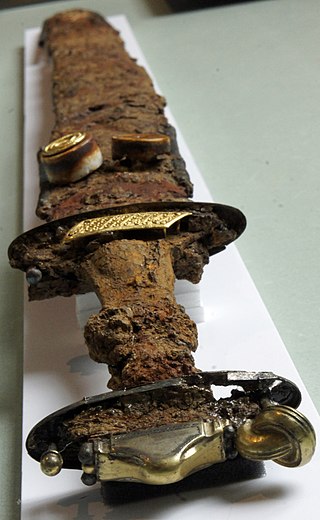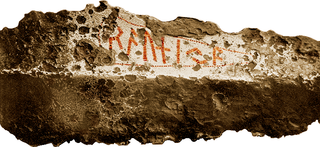
Æsir or ēse are gods in Germanic paganism. In Old Nordic religion and mythology, the precise meaning of the term "Æsir" is debated, with it being able to refer to both the gods in general or specifically to one of the main families of gods, in contrast to the Vanir, with whom they waged war, ultimately leading to a joining of the families. The term can further be used to describe local gods that were believed to live in specific features in the landscape such as fells. In the Old English Wið færstice, the Ēse are referred to, along with elves, as harmful beings that could cause a stabbing pain, although exactly how they were conceived of by the author of the text is unclear.

Wyrd is a concept in Anglo-Saxon culture roughly corresponding to fate or personal destiny. The word is ancestral to Modern English weird, whose meaning has drifted towards an adjectival use with a more general sense of "supernatural" or "uncanny", or simply "unexpected".

Old Norse Yngvi, Old High German Ing/Ingwi and Old English Ing are names that relate to a theonym which appears to have been the older name for the god Freyr. Proto-Germanic Ingwaz was the legendary ancestor of the Ingaevones, or more accurately Ingvaeones, and is also the reconstructed name of the Elder Futhark rune ᛜ and Anglo-Saxon rune ᛝ, representing ŋ.

A wight is a being or thing. This general meaning is shared by cognate terms in Germanic languages, however the usage of the term varies greatly over time and between regions. In Old English, it could refer to anything in existence, with more specific usages arising in Middle English, perhaps due to the term of similar meaning in Anglo-Norman, creature. In modern fantasy, the term is widely used, often meaning specifically a being which is undead.

A rune is a letter in a set of related alphabets known as runic alphabets native to the Germanic peoples. Runes were used to write Germanic languages before they adopted the Latin alphabet, and for specialised purposes thereafter. In addition to representing a sound value, runes can be used to represent the concepts after which they are named (ideographs). Scholars refer to instances of the latter as Begriffsrunen. The Scandinavian variants are also known as fuþark, or futhark, these names derived from the first six letters of the script, ⟨ᚠ⟩, ⟨ᚢ⟩, ⟨ᚦ⟩, ⟨ᚨ⟩/⟨ᚬ⟩, ⟨ᚱ⟩, and ⟨ᚲ⟩/⟨ᚴ⟩, corresponding to the Latin letters ⟨f⟩, ⟨u⟩, ⟨þ⟩/⟨th⟩, ⟨a⟩, ⟨r⟩, and ⟨k⟩. The Anglo-Saxon variant is futhorc, or fuþorc, due to changes in Old English of the sounds represented by the fourth letter, ⟨ᚨ⟩/⟨ᚩ⟩.

The Elder Futhark, also known as the Older Futhark, Old Futhark, or Germanic Futhark, is the oldest form of the runic alphabets. It was a writing system used by Germanic peoples for Northwest Germanic dialects in the Migration Period. Inscriptions are found on artifacts including jewelry, amulets, plateware, tools, and weapons, as well as runestones in Scandinavia, from the 2nd to the 10th centuries.
Algiz is the name conventionally given to the "z-rune" ᛉ of the Elder Futhark runic alphabet. Its transliteration is z, understood as a phoneme of the Proto-Germanic language, the terminal *z continuing Proto-Indo-European terminal *s.
Jera is the conventional name of the j-rune ᛃ of the Elder Futhark, from a reconstructed Common Germanic stem *jēra- meaning "harvest, (good) year".
Geir is a masculine name commonly given in Norway and Iceland. It is derived from Old Norse geirr "spear", a common name element in Germanic names in general, from Proto-Germanic *gaizaz.
*Ehwaz is the reconstructed Proto-Germanic name of the Elder Futhark e rune ᛖ, meaning "horse". In the Anglo-Saxon futhorc, it is continued as ᛖeh.

Proto-Norse or Proto-North Germanic was an Indo-European language spoken in Scandinavia that is thought to have evolved as a northern dialect of Proto-Germanic in the first centuries CE. It is the earliest stage of a characteristically North Germanic language, and the language attested in the oldest Scandinavian Elder Futhark inscriptions, spoken from around the 2nd to the 8th centuries CE. It evolved into the dialects of Old Norse at the beginning of the Viking Age around 800 CE, which later themselves evolved into the modern North Germanic languages.
A runic inscription is an inscription made in one of the various runic alphabets. They generally contained practical information or memorials instead of magic or mythic stories. The body of runic inscriptions falls into the three categories of Elder Futhark, Anglo-Frisian Futhorc and Younger Futhark.
The term man and words derived from it can designate any or even all of the human race regardless of their sex or age. In traditional usage, man itself refers to the species or to humanity (mankind) as a whole.

The Migration Period sword was a type of sword popular during the Migration Period and the Merovingian period of European history, particularly among the Germanic peoples. It later gave rise to the Carolingian or Viking sword type of the 8th to 11th centuries AD.

Witch, from the Old English wiċċe, is a term rooted in European folklore and superstition for a practitioner of witchcraft, magic or sorcery. Traditionally associated with malevolent magic, with those accused of witchcraft being the target of witch-hunts, in the modern era the term has taken on different meanings. In literature, a 'witch' can now simply refer to an alluring women capable of 'bewitching' others. In neopagan religions such as Wicca the term has meanwhile been adopted as the female term for an adherent.
Óslác is a theophoric Anglo-Saxon given name, cognate to Old Norse Ásleikr/Áslákr and to Old High German Ansleh. It is composed of ós "god" and lác "play, sport; offering, sacrifice".
Sowilo (*sōwilō), meaning "sun", is the reconstructed Proto-Germanic language name of the s-rune.

Odin is a widely revered god in Germanic paganism. Norse mythology, the source of most surviving information about him, associates him with wisdom, healing, death, royalty, the gallows, knowledge, war, battle, victory, sorcery, poetry, frenzy, and the runic alphabet, and depicts him as the husband of the goddess Frigg. In wider Germanic mythology and paganism, the god was also known in Old English as Wōden, in Old Saxon as Uuôden, in Old Dutch as Wuodan, in Old Frisian as Wêda, and in Old High German as Wuotan, all ultimately stemming from the Proto-Germanic theonym *Wōðanaz, meaning 'lord of frenzy', or 'leader of the possessed'.
Garibald is a Germanic masculine given name. Garibald was a popular name among the Lombards and Bavarii in the Early Middle Ages, but it is also existed as a personal name among Anglo-Saxons, attested in Searle's Onomasticon Anglo-Saxonicum. Its Lombardic forms are Garipald and Gairipald; in modern Italian it is Garibaldo or Garivaldo, and gives rise to the patronymic Garibaldi, and the adjective garibaldino. Its roots are Proto-Germanic "gairaz", or "gaizaz" and Proto-Germanic "balthaz" (bold). Today the name is used mainly in Italy, to form an ideological connection with the Risorgimento led by Giuseppe Garibaldi.

The Øvre Stabu spearhead is an iron spearhead which bears an Elder Futhark inscription dated to the second half of the 2nd century, making it one of the oldest runic inscriptions preserved. It was discovered on the Øvre Stabu farm at Eastern Toten, Oppland, Norway, in one of two graves, alongside other grave goods. The spearhead is of the Vennolum type and has a length of 28 cm. The runes are incised using a 'zig-zag' technique, and are partly lost due to corrosion.












